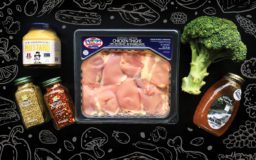Who doesn’t love sugar? After all, it is known to stimulate the pleasure centers of our brains, causing a sense of well-being. Refined cane sugar has its time and place in moderation, but today dozens of alternative sweeteners are available to us. Whether you’re looking for a low-glycemic, low-calorie, or all-natural option, or simply interested in exploring some new flavors outside of regular old table sugar, you’ll find something sweet on our shelves worth checking out! Below you’ll find a sampling of products we offer, separated into Nutritive and Non-Nutritive, which indicates whether they contain calories or not, as opposed to how healthful they are. (Learn more here.) Let us know which is your go-to sweetener in the comments below!

Non-nutritive Sweeteners
Monkfruit

Monkfruit: Photo courtesy of Lakanto
- Comes from a small round fruit native to southern China
- Also known as lo han guo or Swingle fruit (Siraitia grosvenorii)
- Zero calories, zero glycemic index, 200 times sweeter than sugar
Stevia
- Comes from the leaves of the Stevia rebaudiana (Bertoni) plant, native to South America.
- Made by extracting and purifying steviol glycosides from the leaves of the plant
- Zero calories, zero carbs, zero glycemic index, 300 times sweeter than sugar
Erythritol
- Made by fermenting glucose with Moniliella pollinis, a natural microorganism.
- Naturally occurs in some fruits and vegetables including melons and grapes.
- Swerve brand combines erythritol with oligosaccharides in their sweetener. Oligosaccharides are prebiotic fibers sourced from fruits and starchy root vegetables.
- Zero-calorie sugar alcohol that does not affect blood glucose, zero glycemic index, less sweet than sugar

Nutritive Sweeteners
Allulose
- Produced commercially from corn, and exists in nature in small quantities in wheat, jackfruit, figs, and raisins, as well as maple syrup and brown sugar
- Clean taste
- It is a monosaccharide (carbohydrate sweetener) which is not metabolized by the body, making it low-calorie
Xylitol
- Found in small amounts in many fruits and vegetables. It can be processed from trees like birch or from a plant fiber called xylan.
- Beneficial for dental health
- Low-calorie sugar alcohol, low glycemic index
Agave Syrup

Agave harvest: Photo courtesy of Wholesome Sweeteners
- Derived from the agave plant, native to Latin America and the southern USA (Same plant used to make tequila)
- After growing for 5 to 7 years, farmers hand-harvest blue agave, which is then crushed and its carbohydrate- and inulin-rich juice is collected. The agave juice is exposed to different levels of heat to convert the inulin into a fructose and glucose.
- Made up of 75% fructose, 20% glucose, and 5% inulin
- Low glycemic index
Coconut Palm Sugar
- Derived from the nectar of the coconut blossom.
- The nectar is boiled to remove water, leaving coconut sugar.
- Made up of 80% sucrose along with glucose and fructose
- Low glycemic index
Date syrup

Date harvest: Photo courtesy of Just Date Syrup
- Made with California medjool dates.
- Contains magnesium, potassium, and other key vitamins
- Rich in antioxidants
- Delicious unique flavor
- Low glycemic index
Honey
- Made by honey bees! Look for raw options (no heat, filters, or strainers) or strained seasonal honey from local suppliers
- Purchasing from local honey suppliers means promoting the health of pollinators and agriculture in our area
- You’ll find plenty of local brands on our shelves, including Swarmbustin’ and Wild Creek Bee Farm
- Classic, unbeatable flavor
Maple Syrup, Maple Sugar
- Unrefined
- Made from the sap of sugar maple trees
- Purchase real maple syrup from small family farms and coops who are committed to environmental stewardship and sustainable forestry management, such as Coombs and Rocky Ridge
- Contains nutrients and antioxidants
- Real maple syrup is Grade A and comes in four classifications. Learn more here
Unsulphured Molasses

Unsulphured Molasses
- Blackstrap molasses is a byproduct of the sugar cane refining process
- A good source of vitamins and minerals including iron, vitamin B6, potassium, calcium and magnesium
- Full-bodied robust flavor that adds unique color and flavor to baked goods
Brown Rice Syrup
- Made with whole grain brown rice
- A more delicate sweet flavor than honey or maple syrup
- Contains maltotriose, maltose and glucose
- Many brands are low-glycemic
- Try it in this recipe for Vegan Crispy Bars









